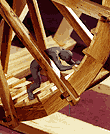1. At the following site, click the LAUNCH INTERACTIVE button,
and then enlarge and explore the details of the different interactive
illustrations.
http://www.pbs.org/wgbh/nova/ancient/parthenon-quarry.html
Explain a) where the Ancient Athenians got the stone they used to build their
temples and
b) how they extracted it from the earth and
c) how they transported it.
Include a small illustration.



Braking system for uphill movement. A pair of wooden, wedge-shaped stops are placed behind the rear wheels. The stops are connected by a wooden rod, itself tied to the underside of the carriage to keep the whole system in place (source of the drawing: Korres 1994).
2. Explain how the Ancient Greeks were able to move heavy stone shapes up a steep hillside.

The 'cancer' (Fig. 10) is a device which tightens its grip as tension increases on its suspension points. All techniques prevent the long blocks from swaying. (source of the drawing: Muller-Wienen 1988).
3. Stone blocks were lifted vertically to the top of a building using a crane.
But what methods did they use to attach the crane ropes to
the stone block?
In your answer also explain how a 'cancer' gripped the stone
block. Include a simple sketch.


|
 |
The hand-drill (Fig. 9)...consists of two parts: the drill itself and a bow-like part attached to the top of the drill. At the top of the drill there is a round wooden handle used to manipulate the drill.
The string of the bow coils
around this handle. The operator applies a vertical force on the
wooden handle with one hand. With the other hand he 'saws' at the
bow. The drill tip...drills or
revolves on either direction.
This means that both the
forward and backward movement of the hand are put to use. It can be
argued that the 'sawing'
movement is just as comfortable, if not more so, as the circular
movement of modern hand-drills. An added advantage is that large
versions of this drill can be operated by two workers, if large
holes are required. Drills of this shape were still in use a few
decades ago in the stone cutting business.
From: http://ergou.simor.ntua.gr/research/
ancientGreece/AncientGreece.htm
| 4. Explain what method the ancient Greeks used to drill
holes. Include a simple sketch. 5. Explain how the tool marked as No. 11( the A shaped tool, with a small triangular shaped piece of lead, hanging from it by a string) was used to make sure that their walls and were vertical and not leaning. |
 SOURCE A |
 SOURCE B |
|
| 6. The above
illustrations are artists impressions of two types of ancient
cranes used to lift heavy objects. a) Pick which is the ancient Ancient Roman style of crane and which is Ancient Greek style of crane. b) Explain what methods the two cranes use to raise a heavy object. |
||
| 7. Now do the
interactive build an Ancient Greek temple activity.
|
||
